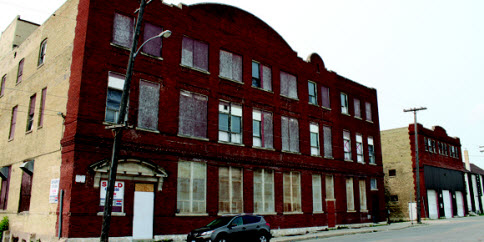by Christian Cassidy
The West End, bounded by Maryland and St. James Streets between Portage and Notre Dame Avenues, did not become part of the city of Winnipeg until 1882. It remained a largely rural enclave until 1904 when the city began to subdivide it for residential development.
Former Canada Bread Bakery (1912)
258 Burnell Street
In 1911, a consortium of Ontario bakeries led by George Weston Ltd. merged to form the Canada Bread Company and set out to create the country’s first national bakery.
In October of that year they took out a $70,000 building permit for this three-storey building on Burnell Street. When it opened in November 1912 Canada Bread claimed that it was the largest bakery west of Toronto with fourteen ovens that could bake four-hundred loaves of bread an hour.
The building was expanded in 1929 to make room for an 80-foot-long (24-metre-long) electric oven, said to be the longest in the Commonwealth. It was capable of baking an impressive 4,000 loaves per hour.
The main bakery building is all that stands now. To the north was a garage structure that, before being converted to house vehicles, were the stables for its 130 delivery horses and wagons.
Canada Bread marketed bread under the Butternut brand in the 1920s and 30s and Toast Master in the 1950s. In 1968, the company bought out Dempster’s Bread Company of Toronto, a brand it marketed nationally.
By the 1990s Canada Bread operated 22 bakeries across Canada but its Winnipeg bakery, the oldest, had become obsolete. The company claimed that the facility was operating at less than 30 per-cent of its capacity and that most local production was contracted out to other, more efficient bakeries.
On October 2, 1998, the Burnell Street bakery was closed and has remained vacant ever since.
Kinsmen Sherbrook Pool (1931)
381 Sherbrook Street
As the “Public Baths” sign above the building’s entrance suggests, the primary objective of early swimming pools was hygiene, not recreation. The city’s health department operated the facilities in the days before all homes were hooked into the city’s water supply in the hopes of encouraging people to come bathe.
Local architects Pratt and Ross’ design called for exterior walls of local rustic brick with Tyndall stone trim. It’s narrow, symmetrical window bays and clean angles make it one of the city’s few examples of art deco architecture.
Inside, the main feature is the tank, which was Winnipeg's first indoor “Olympic size” pool. Some sources credit it as being the only one in the West at the time.
The pool’s $164,000 price tag was offset by the federal government. During the Depression, it offered large subsidies, between 50 and 90 per-cent, of the cost of civic construction projects to keep men off the welfare rolls.
From the time it opened on February 28, 1931 the Sherbrook Pool was a huge success.
Thanks to the pool’s size, it hosted numerous national and international swim meets. When the Pritchard Baths closed in 1947, it became the city’s only indoor pool and for two decades was home to swim clubs, lifesaving classes, a water polo league and year-round swimming lessons.
At its peak, the Sherbrook Pool welcomed up to 150,000 visitors per year. That number dropped considerably after the opening of the Pan Am Pool in 1967.
On November 29, 2012, the Sherbrook Pool was closed when an inspection found that some of the pillars holding up the roof had rusted away.
The future of the pool was in doubt until the city opted for a complete renovation of the building, which included replacing the roof, pool deck, and HVAC systems, as well as the refurbishment of the locker rooms and other public spaces.
The repairs, which cost over $4 million, were offset in part by a $1 million donation from the Kinsmen Club of Winnipeg.
The pool reopened as the Kinsmen Sherbrook Pool in in January 2017.
Templars Hall (1907)
635 Sargent Avenue
Icelanders played a large role in the early development of the West End. Within a few years of its subdivision there was an Icelandic newspaper, school, stores, athletic clubs and churches operating in the community.
Another early institution was International Order of Good Templars (IOGT) which acted as a sort of Icelandic community centre.
This Templars Hall was designed by Samuel Hooper, whose other local works include the Law Courts building and the Carnegie Library on William Avenue. The two-storey brick and stone building cost $18,000 to construct and contains an upper hall with mezzanine that can seat 600 people and a lower hall that can hold 400.
Soon after it opened in 1907, the hall was home to an Icelandic youth group and hosted Icelandic language plays, dances and conferences. It was also rented out to the community at large for political speeches, legion meetings and sports club banquets.
The popularity of the IOGT waned as subsequent generations of Icelanders moved from the area.
In 1958, the building became an Independent Order of Foresters hall, a fraternal, charitable organization that hosted regular fundraising bingos. In 1998, Winnserv took it over and kept the bingo tradition alive to fund their work aiding adults with intellectual disabilities.
Winnserv renamed the building Zoohky Memorial Hall after the late Walter “Zoohky” Ruesch, a much-loved West End resident who rode his bike around the neighbourhood salvaging toys and electronics from back lanes for reuse. He and his bike are depicted in the larger than life mural on the building’s east wall.
In the summer of 2015 the building was sold to the Redeemed Christian Church of God. After extensive renovations, it reopened in 2016 as the More Than Conqueror Parish.



